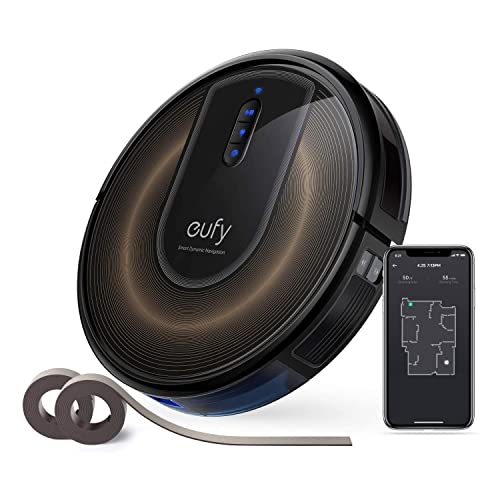
Robot Vacuum Mops
Add a review FollowOverview
-
Founded Date Juli 8, 2016
-
Sectors Specialista Qualità Cliente
-
Posted Jobs 0
-
Viewed 1562
Company Description
Why No One Cares About Cleaning Robot Mop And Vacuum
How to Take Care of a Robot Mop and Vacuum
A robot vacuum and mop will save you time when cleaning. But they also require regular maintenance, including emptying the dirt bins, washing reusable cleaning pads according to manufacturer’s guidelines, getting rid of them after use, and keeping the sensors clean.
App integration lets you set schedules and power modes, as well as save maps and change settings.
1. Clean the Dirt Bin
Most Best Robot Mop Cleaner mops and vacuum cleaners require regular maintenance, including emptying dirt bins, washing pads and keeping track consumables to replace. The more you take care of these components more often, the longer your robotic vacuum and mop will last. Some cleaning robots also need some extra care particularly those with water tanks.
First, ensure that the dustbin is emptied after every cleaning session. This is one of the easiest tasks you can do, but it is essential for the smooth operation of your robot. You should also keep your filter clean regularly. Consult the user manual for your model to determine how often and how often you should clean the filter.
While the mopping function of your robot can remove dust from your flooring, there are tiny particles that can build up in cracks and gaps on flooring. These include hair and dandruff particles dirt, mites and dust and pet hair. To prevent these particles from causing health issues it is crucial to occasionally make use of the vacuum cleaner or sweep robots to clear these areas.
In addition, if you intend to use your robot to mop it is crucial to choose a model that comes with top-of-the-line hardware and large water and dust tanks. LEGEE has one of the biggest dust bins and water tank among its competitors. This means that you won’t have to stop cleaning in order to refill the tank.
Also, don’t put any vinegar or floor cleaners in your robot mop’s water tank unless it is instructed by the manufacturer. These substances can damage your machine and void the warranty.
A robot mop and vacuum is a great tool to help you save time so that you can concentrate on other things that matter, like your family or work. Some stains and dirt are too stubborn for the robot to deal with. You should also periodically use a traditional vacuum to clean the areas that your robot cannot reach.
2. Wash the Cleaning Pads
Depending on how you use your robot mop, the pads may be stained or dirty. This is why it’s essential to clean the pads on a regular basis. You can wash them by hand or in the washer alongside your normal laundry. Avoid using fabric softeners or dryer sheets because they reduce the absorbency of the pad and cause it to not function properly.
If your robot mop also doubles as a vacuum, it will need its dust bin to be empty and cleaned regularly. Hybrid models that can vacuum and sweep with dry mops are also affected. Many robot mops are also equipped with brush attachments that need to be washed.
It is recommended to wash the mop pads thoroughly to remove all dirt and grime. You can also soak them in warm water for several minutes to break loose any debris that has stuck. After they’re clean and dry, you can let them dry on the air or use a low-heat setting in the dryer. It is recommended to clean the pads every two to three months.
During the cleaning cycle, a mop or vacuum is often able to collect small particles which can cause damage to the sensors in your robot and other parts. You can prevent this by wiping the sensors clean with a microfiber cloth from time to time. This will allow the robot to navigate its way around the room without hitting furniture and walls.
Sensors on the base of the majority of robot vacuums and mops are used to detect obstacles, ensuring that the machine won’t get stuck in tight spaces. You’ll need to clean them frequently as they are prone to getting blocked by dust and other particles.
Some robot vacuums have self-cleaning cycles that can be run after every use. Visit the website of the manufacturer to determine if the model you have has this feature. This cycle will typically take about two to three minutes and is possible to run it through an app or button located on the robot. A robot mop and vacuum should be running this cycle on a regular basis to help maintain the performance of its sensors and other components.
3. Clean the Charging Station
The majority of robot mop cleaners spray water or a cleaning solution directly onto the floor to soften staining and then scrub them off using a scrubbing pad. Some robot mops utilize a disposable mop pad, while others can be washed and reused. It is essential to clean and empty your mop pads after cleaning sessions regardless of whether they’re disposable or reusable. Follow the manufacturer’s guidelines. It’s also a good idea to drain the mop base or docking station dry between uses also to prevent the growth of mildew.
Robotic mops, as well as vacuum cleaners, require regular maintenance to ensure they run smoothly. This includes emptying and washing the dust bins, and cleaning the sensors. If you have a robot mop with sensors for dirt it is possible to clean it gently every few cycles to get rid of dust that could hinder the sensors and cause errors in navigation.
Many robot mops come with a smart app that allows you to save maps of your home, set cleaning schedules and even track the time when the machine requires maintenance. If you’re looking to buy a mop, ensure it can be connected to Wi-Fi. This will allow you to access the app from anywhere.
A top-rated model of the Samsung Powerbot Vac + Mop is a smart device with features that help it clean floors without you having to be at home. Its map function lets you to create virtual barriers and no-go zones for the robot, and also manually instruct it to clean a particular space. Its mopping and vacuuming capabilities work on both carpeting and hard floors, which makes it a great choice for homes with both.
This 2-in-1 robot also has a smart object avoidance sensor that helps it navigate around objects such as furniture. It also has a self-emptying bin that reduces the amount that must be cleaned after every use. It can be programmed to run even when you’re away and is ideal for busy homeowners. It’s also quieter than other vacuums, which can be a benefit for those who have pets or children who are sensitive to noise.
4. Clean the Sensors
Most robot vacuums and some mop-and-vacuum models come with an app that lets you create automatic cleaning schedules, choose cleaning modes, and track when the device requires maintenance. The app lets you manually clean and stop, start, and adjust your robot’s settings from anyplace in the house.
The app is especially useful for robotic cleaners with mapping capabilities, such as cameras, lasers or optical dToF that allow it to save a virtual map of the room as well as navigate around furniture. These features can cut down on the frequency of recurring staining on your floor and make cleaning less time-consuming.
When your robot’s mapping sensors become dirty, the device could have trouble finding its way around your home. It is important to clean these sensors regularly, just as you would a camera lens or smartphone screen. This should be done using a dry clean cloth. If you use a moist cloth or cleaner you may damage the sensors and cause them to malfunction.
It’s also recommended to clean your robot vacuum brushes frequently. This will prevent hair tangles from forming and blocking the motor, and will make it easier for your robot to remove particles. It’s a good idea also to clean the primary roller brush, as it’s usually responsible for picking up dirt and can build up a lot of dust over the course of time.
 The last thing to remember is to make sure you only use cleaners that are recommended by the robot’s manufacturer. Using other floor cleaners could damage the machine and void your warranty. The majority of brands recommend a mixture of water and vinegar, or a cleaner that is specifically formulated for their robot. Do not use hot water or abrasive products, as these can damage the internal components of your robot cleaner, and leave the floor soiled. Refer to the owner’s manual for specific instructions on how to clean your robot cleaner. This will help ensure it is operating properly and lasts longer.
The last thing to remember is to make sure you only use cleaners that are recommended by the robot’s manufacturer. Using other floor cleaners could damage the machine and void your warranty. The majority of brands recommend a mixture of water and vinegar, or a cleaner that is specifically formulated for their robot. Do not use hot water or abrasive products, as these can damage the internal components of your robot cleaner, and leave the floor soiled. Refer to the owner’s manual for specific instructions on how to clean your robot cleaner. This will help ensure it is operating properly and lasts longer.
